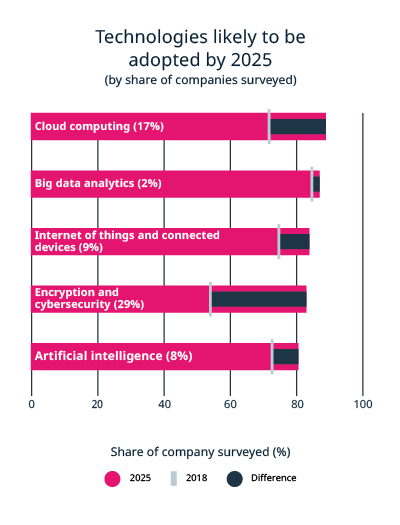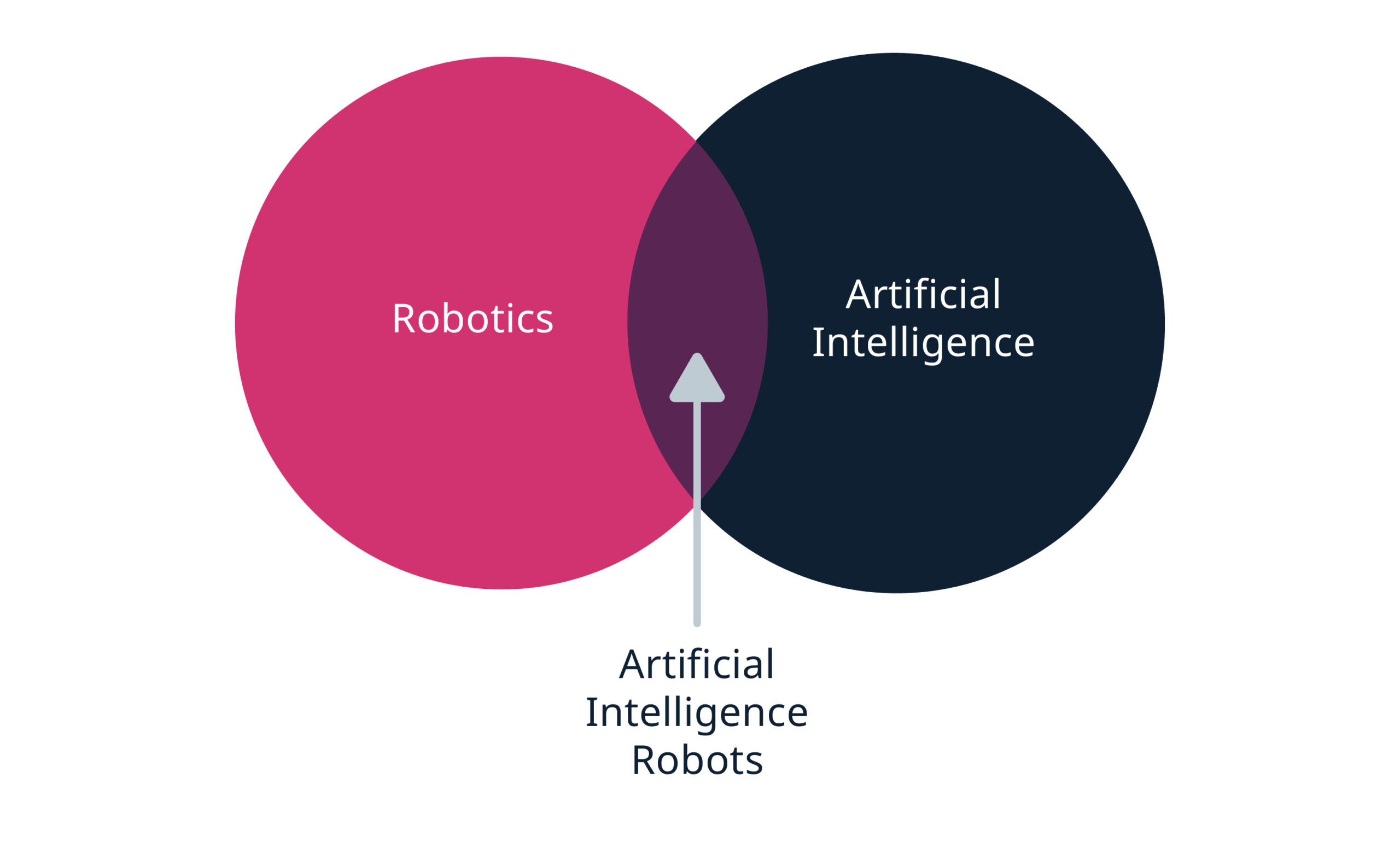Build a Career in Artificial Intelligence and Robotics
As automation grows across industries, so does the anxiety around it. There’s no doubt that automation, robotics, and artificial intelligence (AI) will fundamentally change the role people play in work, but whether it will destroy or create jobs is a more complex answer than a simple ‘yes’ or ‘no’.
Some jobs will certainly become obsolete, but these are mainly low-skilled or positions held by employees with little experience.1 Examples include roles that require physical movement in highly predictable and structured environments, as well as functions where data is collected and processed.
On the other hand, AI and robotics hold the promise of productivity and efficiency gains,2 transforming legacy industries and providing the freedom for new industries to emerge. The World Economic Forum (WEF) estimates that by 2025, technology will create 12 million more jobs than it terminates.3 In generating new positions, opportunities for displaced workers and new labor market entrants will emerge, driving an investment in skills and knowledge that complement the latest technologies.
Thomas Malone, founding director of the MIT Center for Collective Intelligence, explains more about the potential for AI to create jobs now and in the future.
The time has come to adopt AI as a useful augmentation, rather than a potential hindrance. The differentiation is important because AI is:
- In most instances, increasing human capabilities rather than replacing workers
- Creating new scope for innovation
- Opening up new career opportunities4
However, embracing AI isn’t simply about applying new technology in your business – it’s also about being equipped to understand its impact. In the Artificial Intelligence: Implications for Business Strategy online short course from the MIT Sloan School of Management, you’ll be able to underpin AI incorporation in your organization with the expertise to sustain its introduction.
AI is finding the broadest adaptation among the digital information and communications, financial services, healthcare, and transportation industries. According to a WEF survey, AI – including machine learning (ML) and neuro-linguistic programming – is fifth on the list of technologies likely to be adopted by 2025.5

As companies gear up for a future in which humans and machines collaborate in novel ways, career opportunities in robotics and automation are increasing. Let’s take a look at the jobs that will become more important in years to come.
The top automated intelligence careers
Machine learning engineer
Machine learning engineers are in-demand computer programmers with strong software skills who can apply complex predictive models, process large sets of data, and use natural language processing to program machines to perform specific tasks that support business goals.
These engineers work closely with business leaders to build and scale intelligent enterprises while leveraging current systems and processes with the help of technology.
Data scientist
Data science is the heart of AI, automation, and ML. Data scientist roles are projected to grow by 33 percent in the IT sector by 2022, with consistent demand for this role across almost all sectors.6
A data scientist’s primary role is to analyze, visualize, and model large volumes of data to build and implement new ML models to support sound business decisions.
Business intelligence developer
Business intelligence (BI) developers research and plan solutions for problems within a business, and increase profitability by analyzing complex data.7 This includes designing, modeling, testing and maintaining cloud-based data storage systems and subsequently analyzing the data to tap into market and business trends. 8
Software developer
The rapid increase in the number of computer systems and mobile apps that use software has resulted in software developers being in high demand. Their employment is projected to grow 13 percent from 2020 to 2030, faster than the average for all occupations.9
A software developer oversees the entire development process of computer programs for a business and provides the best-suited software for it.10
Robotics scientist
Robotics and AI differ in various ways. To remove a scenario of robotics versus AI, artificially intelligent robots (robots controlled by AI programs) will bridge robotics and AI.11 However, not all robots are artificially intelligent and non-intelligent robots are mostly restricted to performing a repetitive series of movements.
Robotics involves designing, building, and programming physical robots that are able to interact with the physical world. Only a small part of robotics involves AI. Most industrial robots are non-intelligent. Artificial intelligence is a branch of computer science, which involves developing computer programs to complete tasks that would otherwise require human intelligence. AI algorithms can tackle learning, perception, problem-solving, language-understanding, and logical reasoning.12

A robotics scientist builds and maintains the robots that carry out the tasks in an organization that still require human input. Typical sectors in which this is common are manufacturing, security, space and aerospace, and healthcare.
For instance, ML and AI are critical tools in the medical industry’s broad efforts to refine prognostics. In an online program like Artificial Intelligence in Health Care from MIT Sloan School of Management, healthcare professionals can gain a deeper understanding of the deliberate disruption AI and ML can bring to the health sector.
AI research scientist
An AI research scientist operates at an expert level in several AI disciplines, including ML, deep learning, computer perception, applied math, and computational statistics. The demand for AI research scientists is set to increase over the next few years, as these professionals are at the developmental cusp of AI and ML applications.
“I always joke that the safest job on the planet is AI researcher,” says Toby Walsh, an AI professor at the University of New South Wales. “When we’ve automated AI researchers, the machines will literally be able to do everything else by definition.”13
Great potential for a career in AI or robotics
Are you interested in pursuing a career in AI or robotics, or building on the skills you already have? Learn more about this exciting industry by following these steps:
Upskill online
As is the case with most tech-based fields, there are a selection of online courses available for artificial intelligence and robotics, either to learn more about an overall field, or to specialize in one specific topic.14
The Artificial Intelligence Strategy online short course from the UC Berkeley School of Information provides you with access to established professionals who have sustained experience in recognizing opportunities and challenges when developing and implementing a functional strategy.
Read and absorb
AI and robotics are ever-evolving fields, which means it’s important to remain informed about industry changes and new research. Subscribe to scientific journals and explore as many opportunities for learning as possible.
Embrace creative problem solving
Understanding how to apply AI and robotics requires imaginative thinking and craftsmanship. Creative problem-solving encourages you to find fresh perspectives and formulate innovative solutions, to enable you to overcome obstacles and attain goals.
In AI, users can solve the problem by performing logical algorithms, utilizing polynomial and differential equations, and executing them using modeling paradigms. There can be various solutions to a single problem, which are achieved by different heuristics.
When it comes to automated intelligence careers, the landscape is wide and varied, with each role needing a different level of education and experience. With a seismic shift in the presence of AI specialist roles, the professional landscape has the potential to create millions of jobs worldwide.
It’s critical for anyone keen to distinguish themselves in a career in AI, robotics, or automation to prioritize both their career development and society’s larger need to adjust to the significant changes brought about by these technologies.15
Help people and technology work better together
MIT Computer Science and Artificial Intelligence Laboratory
- 1 Casey, M. (Jul, 2020). ‘Looking towards the future: Automation, training, and the middle class’. Retrieved from Brookings.
- 2 Casey, M. (Jul, 2020). ‘Looking towards the future: Automation, training, and the middle class’. Retrieved from Brookings.
- 3 Nunes, A. (Nov, 2021). ‘Automation doesn’t just create or destroy jobs – it transforms them’. Retrieved from Harvard Business Review.
- 4 Kande, M. and Sonmez, M. (Oct, 2020). ‘Don’t fear AI. It will lead to long-term job growth’. Retrieved from WEF.
- 5 (2020). ‘The future of jobs report 2020’. Retrieved from WEF.
- 6 (2020). ‘The future of jobs report 2020’. Retrieved from WEF.
- 7 Muthyala, S. (Jul, 2021). ‘How to start a career in artificial intelligence and machine learning?’. Retrieved from Analytics Insight.
- 8 Adcock, S. (Feb, 2020). ‘These are the exact skills you need to get a job in artificial intelligence’. Retrieved from Ladders $100K Club.
- 9 (Sept, 2021). ‘Occupational outlooks handbook: Developers and digital designers’. Retrieved from BLS.
- 10 (Nd). ‘What is a software developer?’. Retrieved from Computer Science Degree Hub. Accessed November 30, 2021.
- 11 Owen-Hill, A. (Jul, 2021). What’s the difference between robotics and artificial intelligence?‘. Retrieved from Robottiq.
- 12 Owen-Hill, A. (Jul, 2021). What’s the difference between robotics and artificial intelligence?’. Retrieved from Robottiq.
- 13 Christopher, A. (Jun, 2021). ‘Watch out for the top 5 most in-demand AI job skills in 2021’. Retrieved from Albert Christopher.
- 14 Christopher, A. (Jun, 2021). ‘Watch out for the top 5 most in-demand AI job skills in 2021’. Retrieved from Albert Christopher.
- 15 Stahl, A. (Mar, 2021). ‘How AI will impact the future of work and life’. Retrieved from Forbes.
